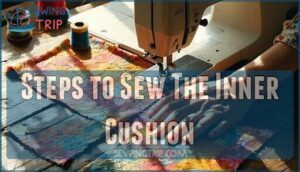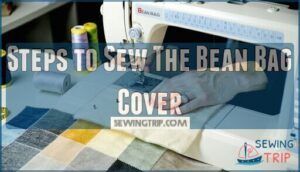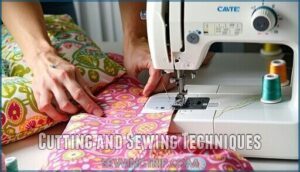This site is supported by our readers. We may earn a commission, at no cost to you, if you purchase through links.

Start with durable fabric like cotton or upholstery material—something tough enough to handle lounging.
Cut two identical pieces in your desired shape (a classic teardrop works well) and sew most of the edges, leaving a gap to fill.
For the stuffing, consider polystyrene beads for that proper bean bag feel or get creative with shredded foam or old clothes.
Once stuffed, sew the gap securely, or add a zipper for refill convenience.
With its customization potential, this project’s as unique as you want it to be—perfect for any casual space!
Table Of Contents
Key Takeaways
- Choose durable fabric like denim or canvas and reinforce seams for a long-lasting bean bag.
- Use fillings like polystyrene beads or shredded memory foam for comfort and shape retention.
- Add a zipper to make refilling and cleaning easy, improving the chair’s functionality.
- Customize designs with creative touches like pockets, handles, or painted patterns to match your style.
DIY Bean Bag Basics
To make a bean bag chair, you’ll need the right materials, sturdy fabric, and proper tools to guarantee durability.
Understanding filling options and basic sewing techniques is key to creating a cozy, functional seat.
Materials and Fabric Selection
Choosing the right fabric is key for a durable, comfortable beanbag.
The fabric you choose defines the bean bag’s durability, comfort, and style—opt for tightly woven, long-lasting materials.
Look for tightly woven materials to prevent filling escape. Sturdy fabrics like denim, canvas, or microfiber add longevity, while upcycled fabrics like old duvets or blankets cut costs.
Budget fabrics, such as drop cloths, work well too. Consider machine-washable fabric for easy maintenance.
Focus on fabric durability and weave tightness for the best DIY bean bag chair.
Filling Options and Considerations
When thinking about bean bag stuffing, filling materials like shredded foam or polystyrene beads are popular for their support and comfort.
Shredded foam and polystyrene beads combine comfort and support, making them top choices for cozy, long-lasting bean bag stuffing.
Eco-friendly filling options include old clothes or rice but watch for potential odors.
Washable fills, like microbeads, are practical for spills.
Consider the fill volume—lightweight Foam Types create a comfy feel, while bead alternatives provide great moldability!
Some prefer shredded memory foam because it retains shape longer.
Sewing and Construction Techniques
Once you’ve chosen your filling, start by cutting your fabric with precise measurements, keeping a seam allowance for durability.
Use sturdy sewing techniques like backstitching and Seam Reinforcement for longevity. Try Corner Boxing to shape edges neatly.
Zipper Installation simplifies cleaning. Adjust patterns as needed for size and comfort.
Fabric Manipulation guarantees smooth curves and snug stitching every time, utilizing techniques like Seam Reinforcement for a professional finish, and considering Corner Boxing for a polished look.
Bean Bag Chair Designs
You can design a bean bag chair to match your style with simple tweaks to patterns, fabrics, or sizes.
Whether you prefer bold shapes or practical designs, there’s an option to fit any space or need.
Customization and Design Ideas
You can make your bean bag truly yours with creative fabric customization.
Try fabric painting or stencil designs for a pop of personality.
Add pockets for snacks or remotes, and don’t forget handle additions for easy movement.
Remember, zipper placement is key for functionality.
Use unique stitching designs to bring life to your bean bag patterns effortlessly.
Creative DIY Bean Bag Chair Designs
Give your DIY bean bag chair a twist with unique shapes like pyramids or teardrops, and try themed fabrics for a personalized look.
Add features like handles or pockets for functionality, and use upcycled materials, like old blankets, to save money.
Kid-friendly designs can include fun prints or patterns, making this sewing project idea both practical and stylish.
Specialized DIY Bean Bag Chair Projects
Looking for unique sewing project ideas? Specialized DIY bean bag chairs are fun and practical for homes.
Try these creative options:
- Kids Beanbags: Perfect for reading nooks or play areas.
- Doll Beanbags: A cute accessory that matches your child’s seating.
- No-Sew Beanbags: Quick and easy, ideal for beginners using upcycled fabric.
Follow a bean bag tutorial for personalized designs! For the outer bag, you can choose corduroy or denim for the fabric.
Making a Bean Bag Chair
You can make a bean bag chair by sewing a durable inner cushion and an outer cover.
With a few basic materials, precise measurements, and simple sewing techniques, you’ll create a comfy spot perfect for lounging.
Steps to Sew The Inner Cushion
Start by pairing two flat sheets for your inner bag. Align the edges, then secure with pins.
Using a sewing machine, stitch three sides together, leaving one partially open for filling access. Reinforce seams for inner durability.
For hand sewing, the backstitch guarantees durability. This sewing project keeps your bean bag sturdy.
A little effort here guarantees your filling won’t escape later!
Steps to Sew The Bean Bag Cover
To sew the bean bag chair cover, focus on aligning your fabric selection with the pattern adaptations.
Pin edges securely, allowing proper fabric tension while stitching. For seamless zipper placement, attach it before sewing sides.
Reinforce seams to boost durability, especially for high-stress zones. Choosing the right bean bag material is essential for the longevity of your project.
Use a sewing machine for precise corner stitching on the outer cover, ensuring a neat finish and utilizing the right technique.
Cutting and Sewing Techniques
Use sewing pins to secure your fabric, allowing for accurate fabric cutting and a consistent seam allowance. Focus on straight seams for clean lines.
Master curved seam sewing by working slowly with your sewing machine. Add strength with seam reinforcement.
For versatility, try the boxed corner technique. A zipper insertion provides access, and pattern alterations guarantee flexibility in design.
Bean Bag Chair Benefits
You’ll save money and get creative control when you make your own bean bag chair.
It’s a versatile seating option that’s easy to customize for comfort, size, and style.
Cost-Effective DIY Options
Save money with a DIY furniture project! Making cheap bean bags at home is budget-friendly and fun.
Embrace DIY benefits by using upcycled materials and budget fabrics. Filling alternatives like polystyrene beads or shredded foam keep costs manageable.
Here’s how to stay costsaving:
- Upcycle fleece blankets or sheets
- Use beans or rice as bean bag filling
- Repurpose old zippers
- Select durable budget fabrics
- Skip expensive extras
Customization and Size Adjustments
A DIY bean bag chair gives you full control over size and shape.
Make a giant bean bag chair for lounging or a kids bean bag chair with fun personalized fabrics.
Add a zipper for easier refilling and cleaning. Experiment with shape variations, from teardrop to round styles, to fit your space perfectly.
Adjusting for teen or adult beanbags is simple too, and you can make a giant bean bag chair for ultimate comfort.
Practical Tips and Variations
Always reinforce seams to withstand frequent use, and plan zipper placement for easy refilling.
Experiment with filling techniques, like layering bean bag filler for firm support. Add handles for portability or pockets to keep essentials close.
A clear bean bag pattern simplifies sewing. With creative touches, your DIY furniture project becomes both practical and personal, following these accessible DIY instructions.
DIY Bean Bag Tips
Getting the right measurements and fabric is essential for a sturdy, long-lasting bean bag chair. Use durable materials like upholstery fabric and consider vacuum-packing for easier filling and storage.
Proper Measurements and Fabric Choices
When planning measurements, size precision is key for comfort.
Choose fabric based on durability and shape retention.
For a round bean bag, calculate the diameter and circumference carefully.
Add a seam allowance to avoid tight fits during sewing.
Pattern matching helps prevent mismatched designs.
Consider various types of material for your project.
Verify that fabric dimensions suit your needs, keeping extra length for adjustments.
Accurate planning simplifies the process, ensuring a comfortable and durable bean bag.
Using Upholstery Fabric for Durability
For a long-lasting bean bag chair, pick upholstery fabric. Its weave density and abrasion ratings guarantee durability, even with frequent use.
Check for stain resistance and colorfastness tests to keep it looking fresh. When sewing, use reinforced seams and sturdy threads.
Here’s what to look for in upholstery fabric:
- Tight weave
- High abrasion rating
- Stain resistance
- Fade resistance
- Smooth texture
To ensure the bean bag chair remains durable and looks fresh, consider the abrasion ratings and other factors mentioned above.
Vacuum Packing and Storage Considerations
Storing your bean bag? Vacuum packing saves space while protecting the bean bag filler. Use sturdy vacuum bags and make certain airtight sealing to maintain filling integrity.
Wrap the bean bag cover in plastic to prevent moisture. For long-term storage, a cool, dry area works best.
To prevent deterioration, consider minimizing light exposure. Re-fluffing methods like shaking help restore shape, keeping your space-saving furniture comfy.
Frequently Asked Questions (FAQs)
Can you make a bean bag chair?
Did you know making a bean bag can save $150 compared to buying one?
Start with sturdy fabric like denim, cotton, or canvas, and fill it with shredded foam or polystyrene beads for comfort.
How long does it take to sew a bean bag chair?
Sewing a bean bag chair takes about 2 to 4 hours, depending on your sewing skills and design complexity.
Cutting fabric, stitching seams, and adding zippers or handles all add time but are straightforward steps.
How do you make a convertible bean bag chair?
Think of it like turning a puzzle into comfort.
Sew a bean bag cover with durable fabric and zippers.
Add foam pieces as filler, then make a detachable top cushion to convert into seating.
How do you decorate a beanbag chair?
Add flair to your beanbag chair with fabric paint, stencils, or tie-dye.
Attach decorative patches, pockets, or handles for a fun touch.
Customize further by sewing on appliques or embroidering names for a personal vibe.
How do you make a soft bean bag chair?
Picture sinking into a cloud—create a soft bean bag chair by sewing tightly woven fabric like fleece or velour.
Use shredded memory foam for plush comfort, add a zipper for refilling, and securely stitch seams.
Can you make a bean bag chair on dry land?
Sure, you can make a bean bag chair anywhere, even on dry land.
Just gather durable fabric, stuffing, and basic sewing tools.
Follow simple stitching steps, and voilà—your cozy chair is ready.
Is it cheaper to buy or make a bean bag?
It’s usually cheaper to make a bean bag chair if you’ve got upcycled materials or sewing skills.
Buying one can cost over $150, while DIY options let you customize size and fabric for less.
What is the best filling for bean bags?
Imagine sinking into the perfect bean bag—soft, supportive, and cozy.
Opt for shredded memory foam for comfort and shape retention, or try microbeads for a washable option.
Avoid packing peanuts; they’re uneven and uncomfortable.
What is the filling in a bean bag chair?
Bean bag chair filling typically consists of expanded polystyrene (EPS) beads, shredded foam, or micro beads.
You’ll find EPS beads most common, while shredded memory foam offers better comfort and shape retention for your seating experience, providing a notable difference with expanded polystyrene.
What is the best filling for throwing bean bags?
Dried beans, rice, or plastic pellets work best for throwing bean bags.
You’ll want materials that won’t break apart on impact and maintain consistent weight distribution for accurate throws during games.
Conclusion
Creating your own DIY bean bag chair blends creativity with practicality, much like crafting a modern-day cozy throne.
By choosing durable fabrics, exploring unique filling options, and mastering basic sewing techniques, you can design a custom piece that perfectly suits your space.
Don’t forget the convenience of adding a zipper for easy refills or tweaks.
Whether it’s for lounging, reading, or gaming, this simple project turns functionality into art while offering a personalized and cost-effective seating solution.














